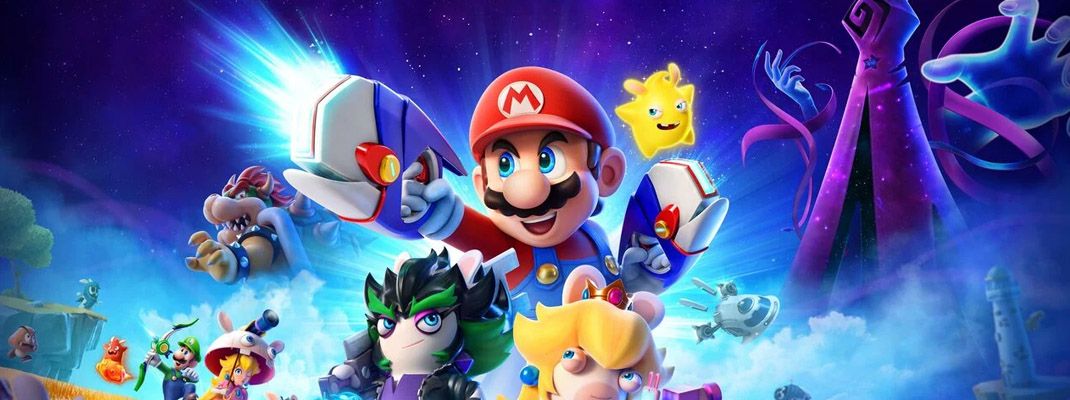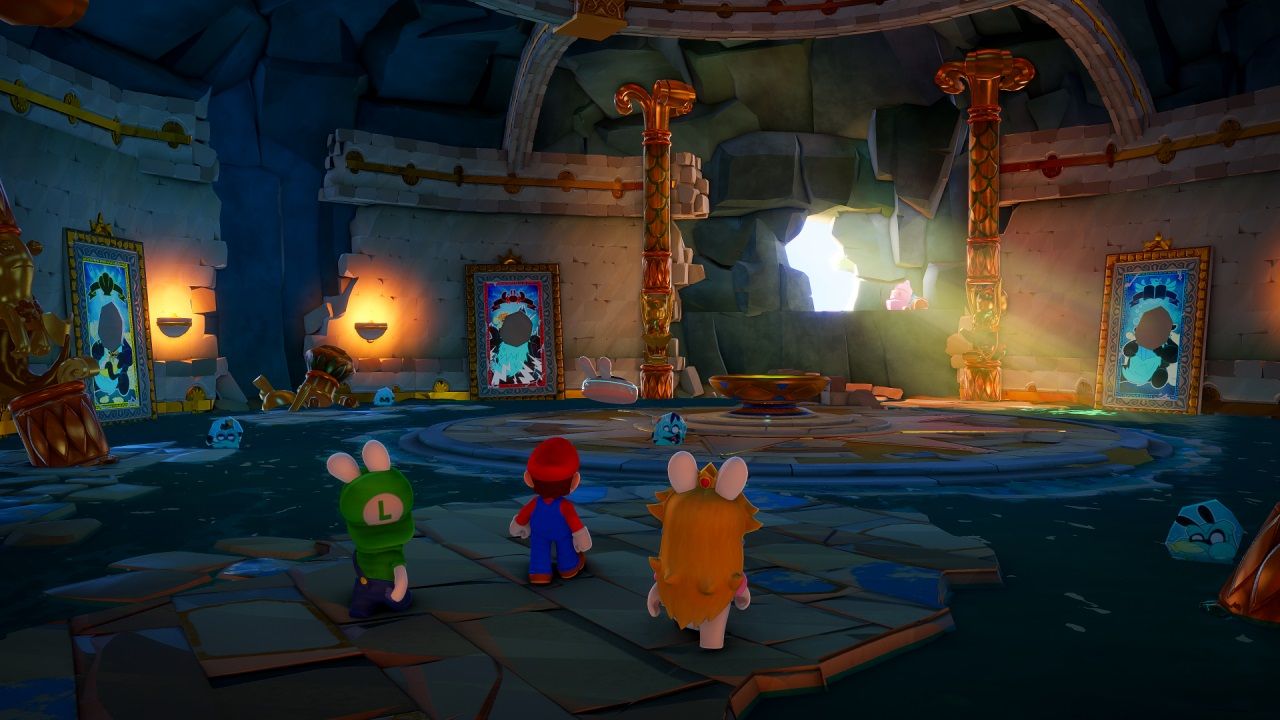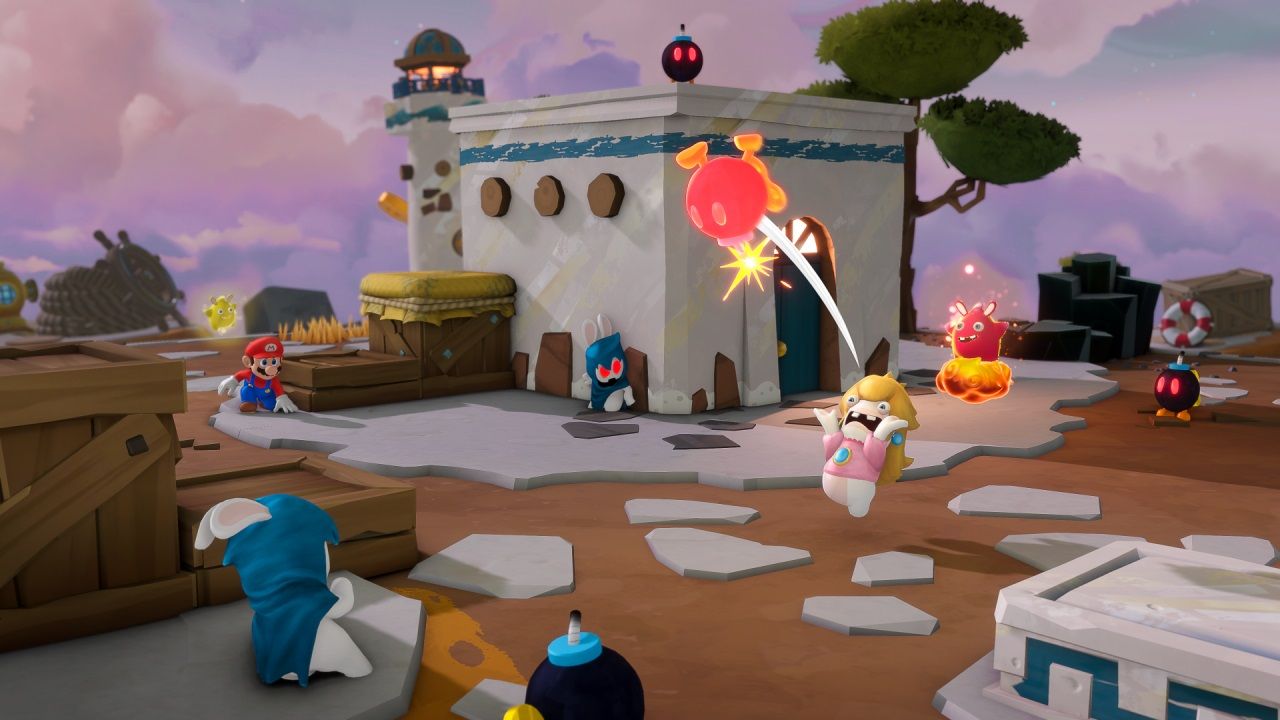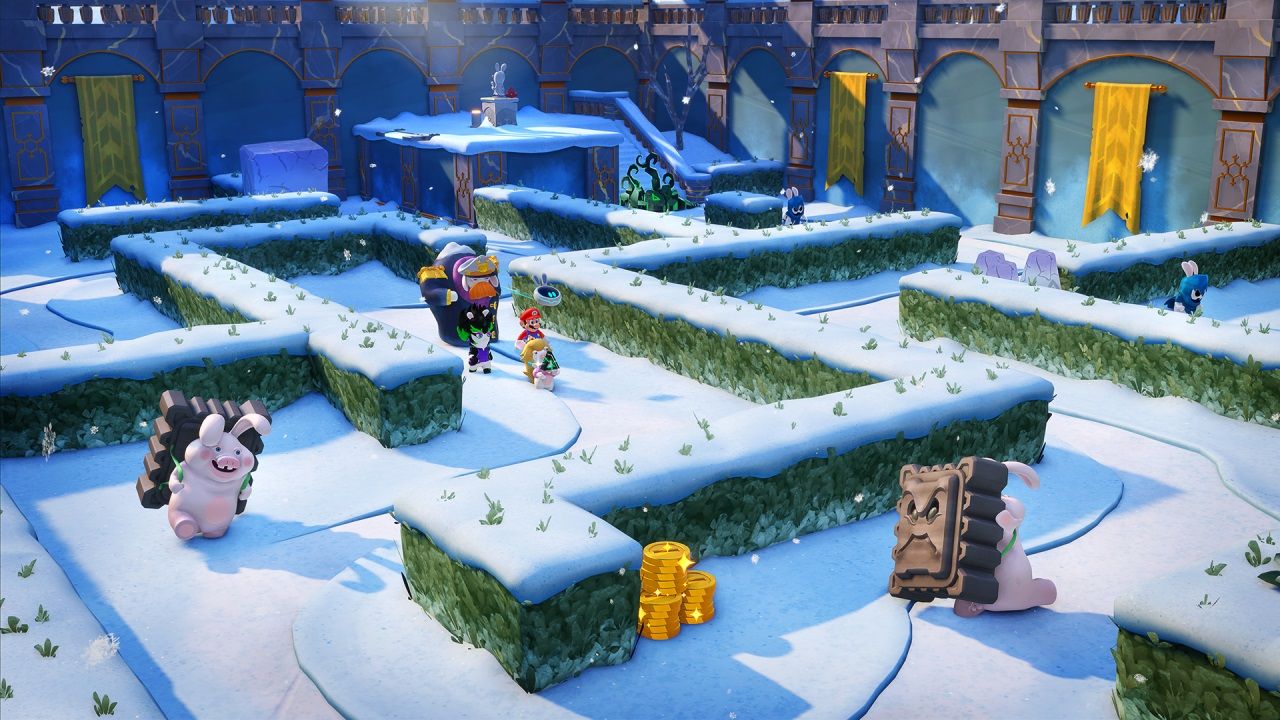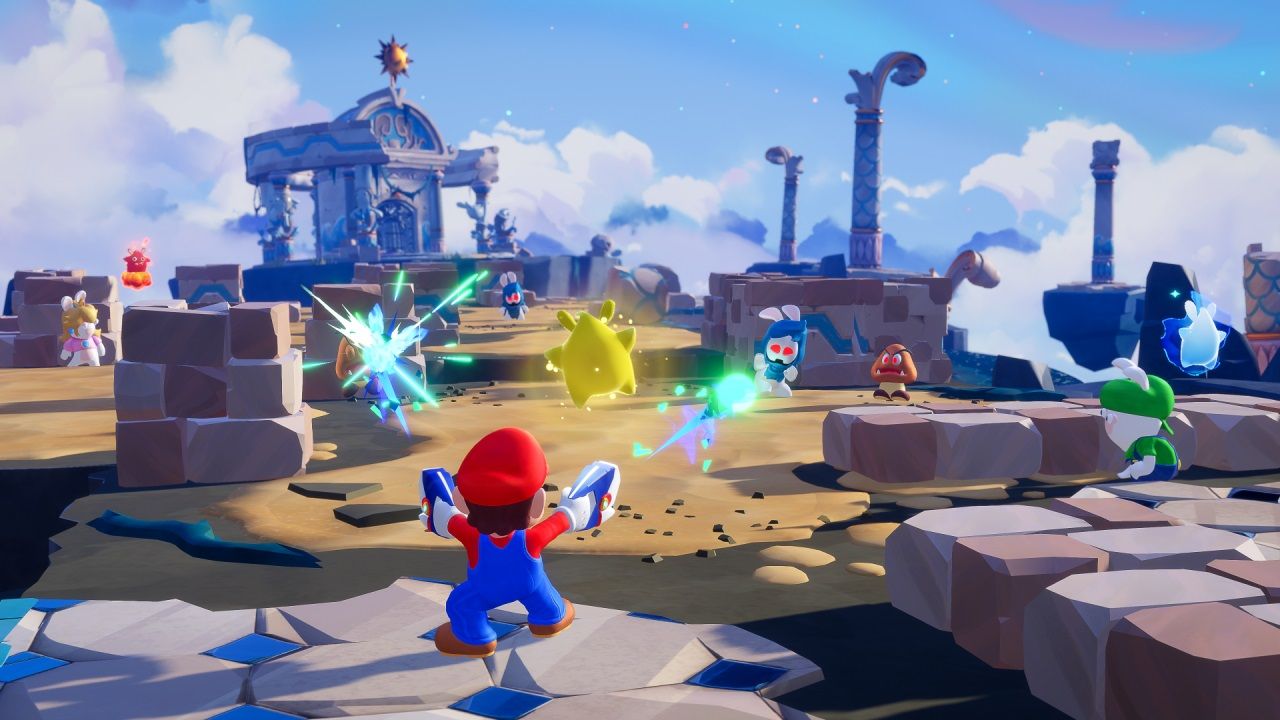As one of the first icons of gaming, Mario is no stranger to crossover titles, whether he’s traveling the world to compete in Olympic events against Sonic and pals, or he’s taking on competitors from an impressive number of third-party franchises in Super Smash Bros. But the success of Ubisoft’s Mario + Rabbids Kingdom Battle didn’t just come out of left field because of the surprising partnership, but due to the unexpected genre as well, as the sight of fan favorites from the Mushroom Kingdom and screaming creatures from the Rayman spin-off holding guns and fighting in turn-based battles is still a strange sight to see to this day. Nevertheless, Ubisoft managed to win over Nintendo and ended up creating one of the Switch’s best third-party exclusives and one of the most creative tactics games to date that offered plenty of challenge for newcomers and veterans of the genre alike. The game wasn’t without its shortcomings, as much of the content outside of the combat felt more like filler than fleshed-out puzzles, while the grid-based movement during battles felt limiting in ways that worked both for and against the game. Five years later, Ubisoft Milan and Ubisoft Paris have teamed up to create its sequel, Mario + Rabbids Sparks of Hope, which looks to address the issues from the original while also expanding the roster of heroes and galactic scope as Mario, his Mushroom Kingdom pals and the Rabbids leave Peach’s castle behind to save the galaxy once again.
Sparks of Hope picks up after the chaotic events of Kingdom Battle, as things have finally settled down and the inhabitants of the Mushroom Kingdom have figured out how to live peacefully with their new long-eared companions. Of course, nothing ever stays peaceful for Mario and crew for long, as Cursa, a dark and mysterious entity with the power to control Darkmess, makes her presence known, forcing Mario, Luigi, Princess Peach and their Rabbid counterparts to flee their home aboard a spaceship alongside Beep-0 and the ship’s AI known as Jeanie. From there, the makeshift crew travels to five different planets that have been plagued by Darkmess, attempting to restore the planets to their natural states and retrieving purified Darkmess crystals in order to reach Cursa’s stronghold.
Along the way, they’re chased by Spark Hunters who seek the titular creatures, a bizarre combination of Rabbids and the star-shaped Lumas from Super Mario Galaxy, which offer unique powers to those who wield them. While none of the villains are particularly memorable, the new additions for the heroes are all standouts, as the brooding Edge, tired Rabbid Rosalina and fiery Bowser each bring their own flavor to the dysfunctional family. Sparks of Hope is more ambitious with its storytelling capabilities with a far greater amount of partially voice-acted dialogue than the original game, but the written jokes are almost always surpassed by the physical comedy present in cutscenes or when exploring the world, and the “reveals” of the plot in its later stages can be seen from multiple planets away. Still, the story does a sufficient enough job of moving players along from one location to the next across its twenty hour campaign, and will likely appeal more to the game’s younger audience.
Unlike in Kingdom Battle where the player characters are forced to follow behind Beep-0 and Mario must always be the leader, Sparks of Hope givers players the freedom to form their own duo and trio from any of the nine cast members, with each having their own amusing style of walking and running as Beep-0 floats above and the others trail behind. And you will end up doing plenty of both as you explore these medium-sized hub worlds that are jam packed with puzzles, side quests, challenges and other secrets to uncover. Outside of the intentionally-challenging riddles offered by Professor Backpack, most of the logic puzzles are well thought out and easy to get invested in without slowing down progress towards the next objective, as players who are willing to explore the environment to find breakable walls and hidden pathways by using Beep-0’s new abilities will often find the next step forward with minimal issues as well as additional rewards. These curious players may also stop to look at various paintings hung up throughout the levels, as Beep-0 and Jeanie provide additional commentary about the backstory of the planet and the main Warden character that watches over it.
Wandering enemies, which now include both cursed Rabbids and familiar Mushroom Kingdom creatures, stroll about and will chase players who get too close, teleporting them to short encounters for extra XP to level up each character’s skill tree, coins and star bits which are used to power up Sparks. Coins can be spent before battles to restore HP and at the shop for items that can be used during battles, while planet coins can be acquired by completing side quests and other objectives to unlock additional lore known as Memories, new skins for your weapons or a planet key to gain access to one of the two Spark quests located on each planet. While players will also be given Sparks simply by making progress through the campaign, the most substantial side content available will typically reward players with additional Sparks for those who are willing to take on its tougher encounters. Players who seek 100% completion could easily double their playtime by seeking out every planet coin, Spark and collectible that each planet has to offer, but a good portion of the side content will remain locked until players complete the main objectives and restore the planet for its inhabitants.
In combat, the restrictive grids of Kingdom Battle have disappeared, allowing characters to move freely within their allotted range, and more real-time elements have been introduced as well. Dashes and team jumps have both returned as moves that can be performed without spending action points, but players are now free to maneuver in the air as Beep-0 carries them to their next landing spot, and enemies like Bobombs can be dashed into, picked up and tossed into a nearby group of enemies for extra damage. As the battlefields progress in complexity, additional jump pads and pipes are utilized to allow players to traverse large sections of the arena in a single turn, which comes in handy when attempting to flank enemies. It can also prove useful for encounters that don’t require players to defeat every enemy on the screen, helping them more quickly get in range of the designated targets or reach the objective area without spending unnecessary time and health fighting foes that spawn in through Darkmess portals. The game’s willingness to frequently experiment with unique battlefield designs is one of its greatest strengths, providing each combat scenario with additional strategic depth and helping them feel fresh without ever getting too repetitive.
After players have found the right position to attack from and used up their free moves, action points must now be spent to fire weapons, use a signature ability or take advantage of Sparks, with the latter two operating based on cooldowns. The unique nature of each character’s firearms and ultimate allow players to utilize multiple styles of attacking from a single trio of heroes, as Luigi’s long-range bow and arrow can be complemented by Rabbid Mario’s high-damage blasts up close from his Dukes, while both Peach and her Rabbid counterpart can heal and protect their allies with their signatures. Edge’s boomerang-style sword proved to be the most useful of the new additions, allowing multiple targets to be hit multiple times as the blade travels to and from its owner. But the Sparks are the true gamechanger, as each character can equip one or two at a time with each having its own active and passive ability. From elemental attacks that infuse weapon shots or cause meteors to rain down from the sky, to defensive abilities that scare away nearby enemies or revive fallen allies, and even the option to go fully invisible for consecutive turns while still being able to fully move and attack, the thirty unlockable Sparks offer an astonishing amount of combos that can be switched out before any battle and can shift the tide of a battle in a single turn. With up to four effective options for each hero, players who take advantage of the best possible plan of attack can deal out massive damage and keep their allies safe before the opposition even gets started, resulting in a combat system that rarely feels stale and continues to impress as the game goes on.
In addition to Goombas, Magikoopas and other Mushroom Kingdom foes, the majority of the enemies that you will be facing are evil Rabbids, with regular-sized Rabbids that can attack from afar and larger ones with bigger health bars that will deal substantial damage if you let them get too close. Each has their own weakness that can be observed by flying Beep-0 around the battlefield at any point during your turn, but they also have devastating abilities of their own, including the option for select enemies to stop players from performing attacks or even moving in the first place. Remaining focused on the objective while also keeping an eye on the location of all enemies in range can prove tricky, particularly as new ones spawn in and tip the battle in their favor. This balance is manageable throughout the first few planets, but the late game encounters and boss battles have no reluctance to overwhelm the player with an amount of enemies that can’t all be attacked in a single turn, leading to frustrating scenarios where players are forced to end their turn and watch as their team gets demolished with no help in sight. This can lead to some demoralizing defeats, particularly in battles where your team is at or just below the recommended level, but the game does offer the option for players to switch the difficulty and modify other elements of combat at the start of each battle, even going so far as to allow full invincibility while still rewarding XP and currency after a completed battle.
Whether playing handheld or on the big screen, the presentation of Sparks of Hope is top notch, with expressive animations in both the cinematics and gameplay that add plenty of personality, and a large supporting cast that need little time to charm the player with their bizarre or amusing appearance. The variety of environments throughout the game may leave players feel wanting, with biomes that rarely feel like they take full advantage of the possibilities of intergalactic travel, but the contrasting nature of arriving on a new planet at its lowest point and leaving it rejuvenated and alive again brings a consistent sense of satisfaction along with new areas to explore. The soundtrack does an excellent job of matching these two different planetary statuses, with an all-star team of composers that know exactly how to complement the joy and whimsy of this strange crossover universe. A few brief frame drops did plague cutscenes and transitions between allies and enemies during combat, but they never impacted our ability to play the game, and the game as a whole is largely polished and free of bugs.
Closing Comments:
Mario + Rabbids Sparks of Hope is an exciting step forward for the series that continues to surprise with its increasingly deep combat, gratifying exploration and joyful presentation. Ubisoft has embraced freedom in all senses of the word for this sequel, whether its additional real-time elements during combat, the ability to switch out and upgrade heroes and Sparks at will for endless combinations, or the oodles of optional content that's crammed into every planet. The predictable and occasionally long-winded story along with late game encounters that severely punish players for mistakes or missed opportunities may keep some players from seeing this journey to its conclusion. Even so, the game’s continued willingness to evolve its approach to new battles and to encourage and reward curiosity in between encounters combine to create a well-paced and engaging tactics game that Switch owners and fans of the genre shouldn’t hesitate to check out.

